Everyone is talking about AI. Advancements like OpenAI’s Dall-E generating images from text prompts and DeepMind using AI for protein structure prediction show the technology’s incredible potential. Natural language processing breakthroughs are even enabling more intelligent chatbots and search engines.
But here’s the thing – while AI holds numerous promises, it can be tricky to navigate all its hype. Numerous opinions on different programming languages and frameworks can leave your head spinning. So, in this post, we will walk you through the top languages used for AI development. We’ll discuss key factors to pick the best AI programming language for your next project.
Best programming languages for AI
Let’s explore what makes these AI programming languages so popular and their specific use cases.
1. Python
Python has become the general-purpose programming language for AI development due to its data visualization and analytics capabilities. It has a user-friendly syntax that is easier for data scientists and analysts to learn.
The language’s garbage collection feature ensures automatic memory management, while interpreted execution allows for quick development iteration without the need for recompilation.
One of Python’s strengths is its robust support for matrices and scientific computing, thanks to libraries like NumPy. This provides a high-performance foundation for various AI algorithms, including statistical models and neural networks.
The language boasts a range of AI-specific libraries and frameworks like scikit-learn, TensorFlow, and PyTorch, covering core machine learning, deep learning, and high-level neural network APIs.
What is Python used for in AI?
In AI, Python is used for machine learning systems, computer vision applications, natural language processing, and general AI prototyping. It excels in predictive models, neural networks, deep learning, image recognition, face detection, chatbots, document analysis, reinforcement, building machine learning algorithms, and algorithm research.
Tip: Avoid Python if you want to accomplish computationally intensive tasks that require careful consideration of project requirements.
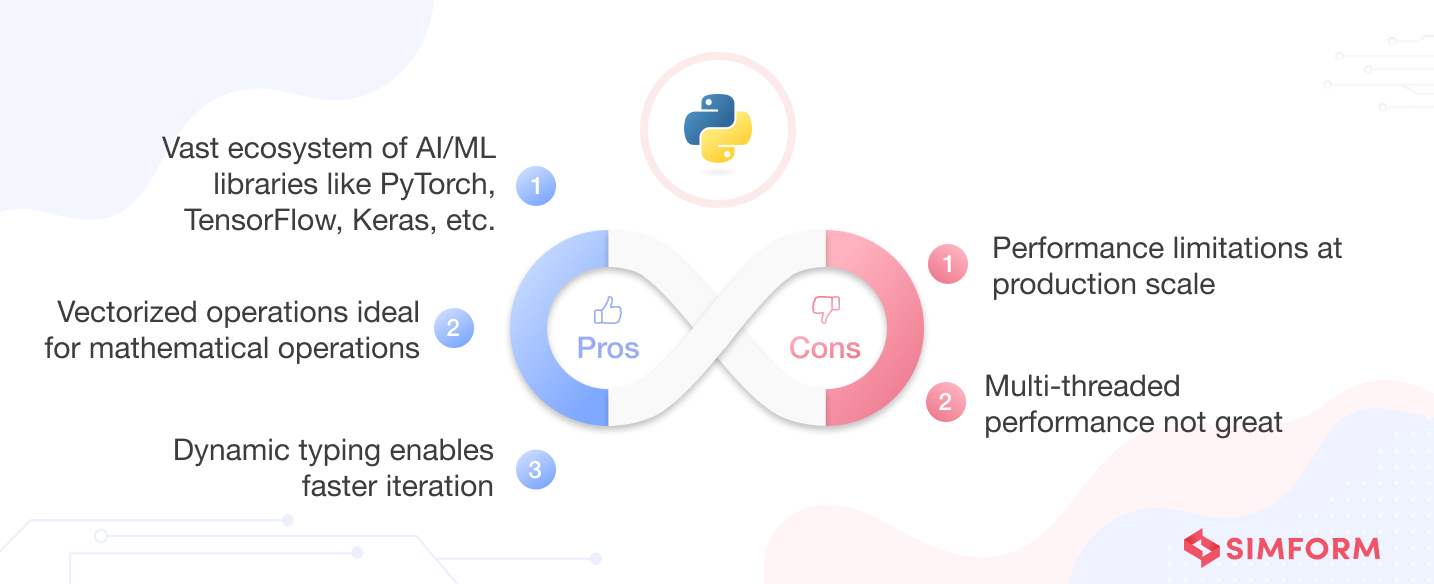
2. R
R is the go-to language for statistical computing and is widely used for data science applications. It shines when you need to use statistical techniques for AI algorithms involving probabilistic modeling, simulations, and data analysis.
R’s ecosystem of packages allows the manipulation and visualization of data critical for AI development. The caret package enhances machine learning capabilities with preprocessing and validation options.
Plus, custom data visualizations and professional graphics can be constructed through ggplot2’s flexible layered grammar of graphics concepts. TensorFlow for R package facilitates scalable production-grade deep learning by bridging into TensorFlow’s capabilities.
What is R used for in AI?
R has a range of statistical machine learning use cases like Naive Bayes and random forest models. In data mining, R generates association rules, clusters data, and reduces dimensions for insights. R excels in time series forecasting using ARIMA and GARCH models or multivariate regression analysis.
R is also used for risk modeling techniques, from generalized linear models to survival analysis. It is valued for bioinformatics applications, such as sequencing analysis and statistical genomics.
Tip: Use R for early-stage experimentation and research. It is not good for later stages, like deploying machine learning into real-world products, as it does not have compilers and memory management. Plus, it has a learning curve for those outside data science disciplines.
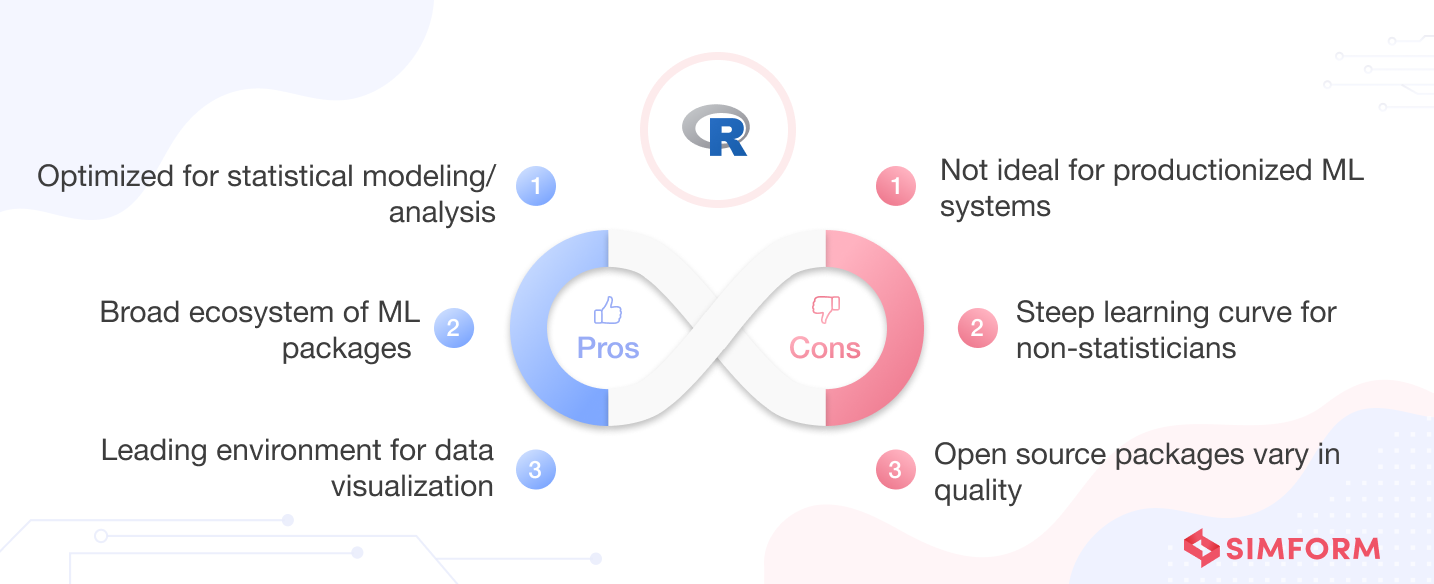
3. Java
Java is used in AI systems that need to integrate with existing business systems and runtimes. The JVM allows AI deployment while keeping codebase compatibility. Its massive ecosystem provides extensive libraries, tools, stable runtimes, abundant developers, and cross-platform portability, which makes it easy to build and deploy AI apps that work across different hardware and software.
For instance, DeepLearning4j supports neural network architectures on the JVM. The Weka machine learning library collects classification, regression, and clustering algorithms, while Mallet offers natural language processing capabilities for AI systems.
What is Java used for in AI?
Java is well-suited for standalone AI agents and analytics embedded into business software. Monitoring and optimization use cases leverage Java for intelligent predictive maintenance or performance tuning agents. You can build conversational interfaces, from chatbots to voice assistants, using Java’s libraries for natural language processing.
Java also empowers recommendation engines to suggest relevant products, targeted advertising, and more.
Tip: Use Java for large business AI systems that want to take algorithms and turn them into reliable software because it has good speed, reliability, and ability to run on many devices.
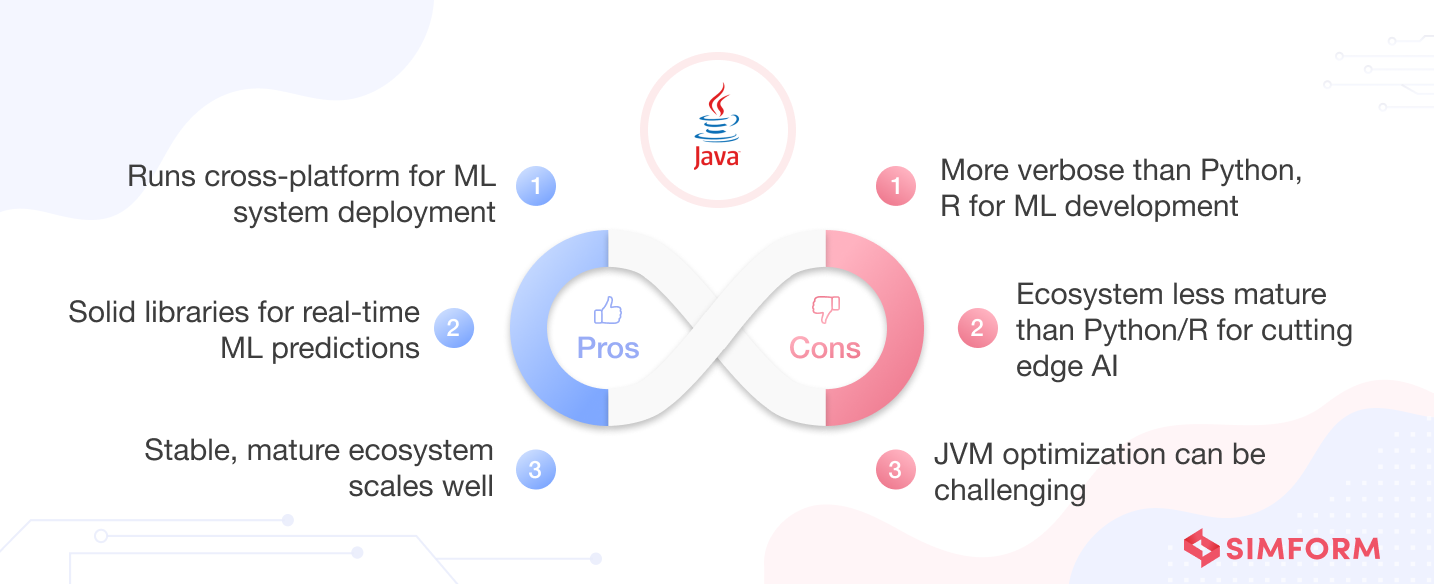
4. Julia
Julia uses a multiple dispatch technique to make functions more flexible without slowing them down. It also makes parallel programming and using many cores naturally fast. It works well whether using multiple threads on one machine or distributing across many machines.
One of Julia’s best features is that it works nicely with existing Python and R code. This lets you interact with mature Python and R libraries and enjoy Julia’s strengths.
Moreover, Julia’s key libraries for data manipulation (DataFrames.jl), machine learning (Flux.jl), optimization (JuMP.jl), and data visualization (Plots.jl) continue to mature. The IJulia project conveniently integrates Jupyter Notebook functionality.
What is Julia used for in AI?
Julia is rapidly adopted for data science prototyping, with results then productionized in Python. Additional use cases leverage Julia’s computational strengths – scientific simulations and models, bioinformatics and computational biology research, time series analysis, and signal processing workflows. Julia’s mathematical maturity and high performance suit the needs of engineers, scientists, and analysts.
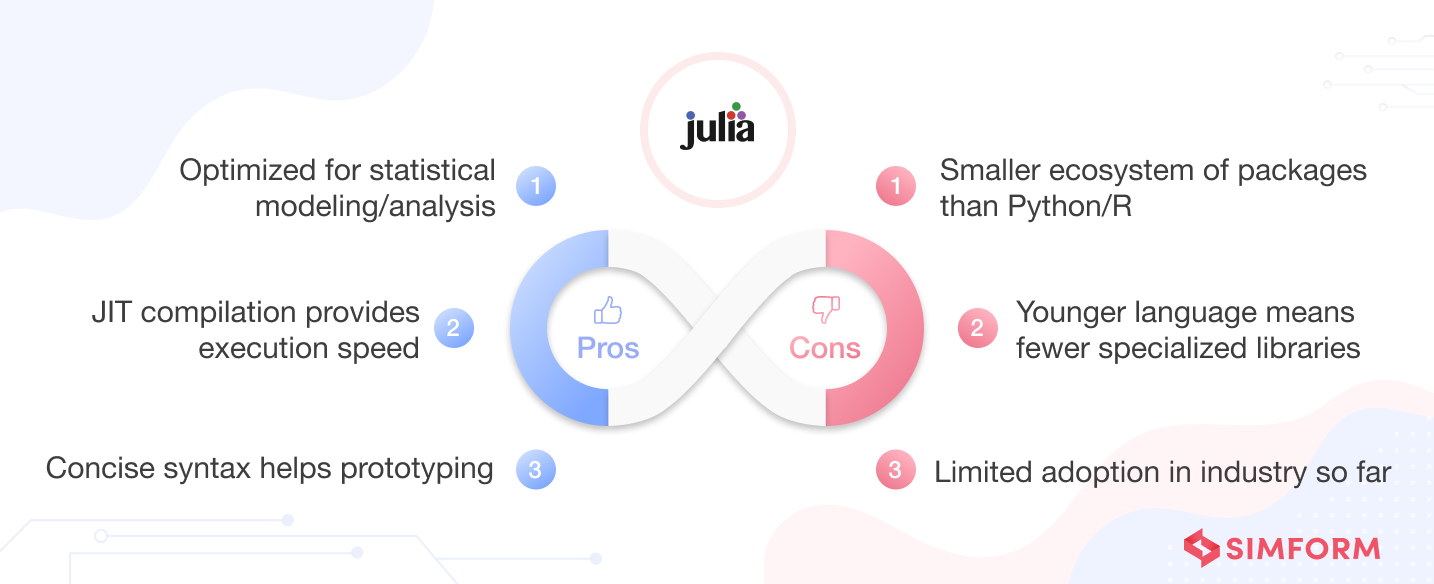
5. JavaScript
JavaScript is used where seamless end-to-end AI integration on web platforms is needed. The goal is to enable AI applications through familiar web programming. It is popular for full-stack development and AI features integration into website interactions.
Plus, JavaScript uses an event-driven model to update pages and handle user inputs in real-time without lag. The language is flexible since it can prototype code fast, and types are dynamic instead of strict.
As for its libraries, TensorFlow.js ports Google’s ML framework to JavaScript for browser and Node.js deployment. The brain.js neural network API provides flexible deep learning. Synaptic.js offers architecture-agnostic neural networks. And Node-RED’s visual workflow simplifies model integration.
What is JavaScript used for in AI?
JavaScript toolkits can enable complex ML features in the browser, like analyzing images and speech on the client side without the need for backend calls. Node.js allows easy hosting and running of machine learning models using serverless architectures.
With frameworks like React Native, JavaScript aids in building AI-driven interfaces across the web, Android, and iOS from a single codebase. While GPU acceleration and other specialized libraries will always enable lower-level languages to train more advanced models from scratch, JavaScript’s versatility helps integrate intelligent features into media-rich applications.
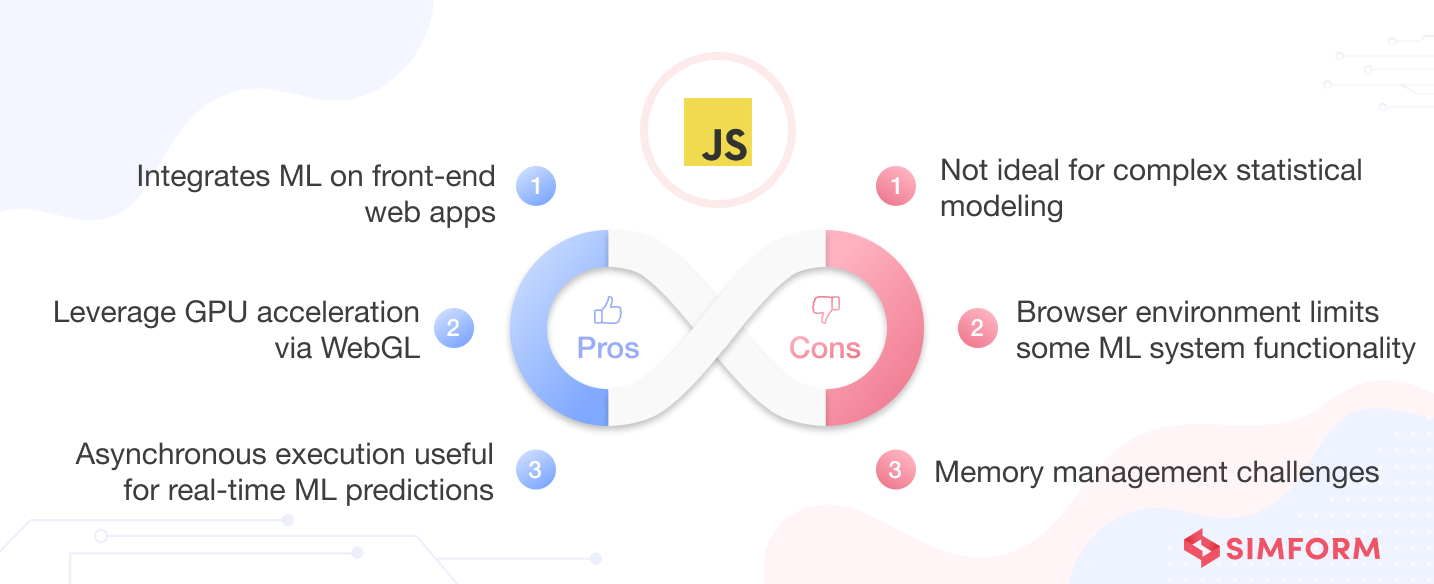
6. C++
If you want to deploy an AI model into a low-latency production environment, C++ is your option. As a compiled language where developers control memory, C++ can execute machine learning programs quickly using very little memory. This makes it good for AI projects that need lots of processing power.
Plus, any C++ code can be compiled into standalone executable programs that predictably tap high performance across all operating systems and chips like Intel and AMD. It allows complex AI software to deploy reliably with hardware acceleration anywhere.
As for the libraries, the TensorFlow C++ interface allows direct plugging into TensorFlow’s machine-learning abilities. Caffe2 is another library specifically for deep learning tasks. ONNX defines a standard way of exchanging neural networks for easily transitioning models between tools. In addition, OpenCV provides important computer vision building blocks.
What is C++ used for in AI?
C++ excels for use cases needing millisecond latency and scalability – high-frequency trading algorithms, autonomous robotics, and embedded appliances. Production environments running large-scale or latency-sensitive inferencing also benefit from C++’s speed. Moreover, it complements Python well, allowing for research prototyping and performant deployment.
Tip: Use C++ with Python to build scalable AI prototypes.
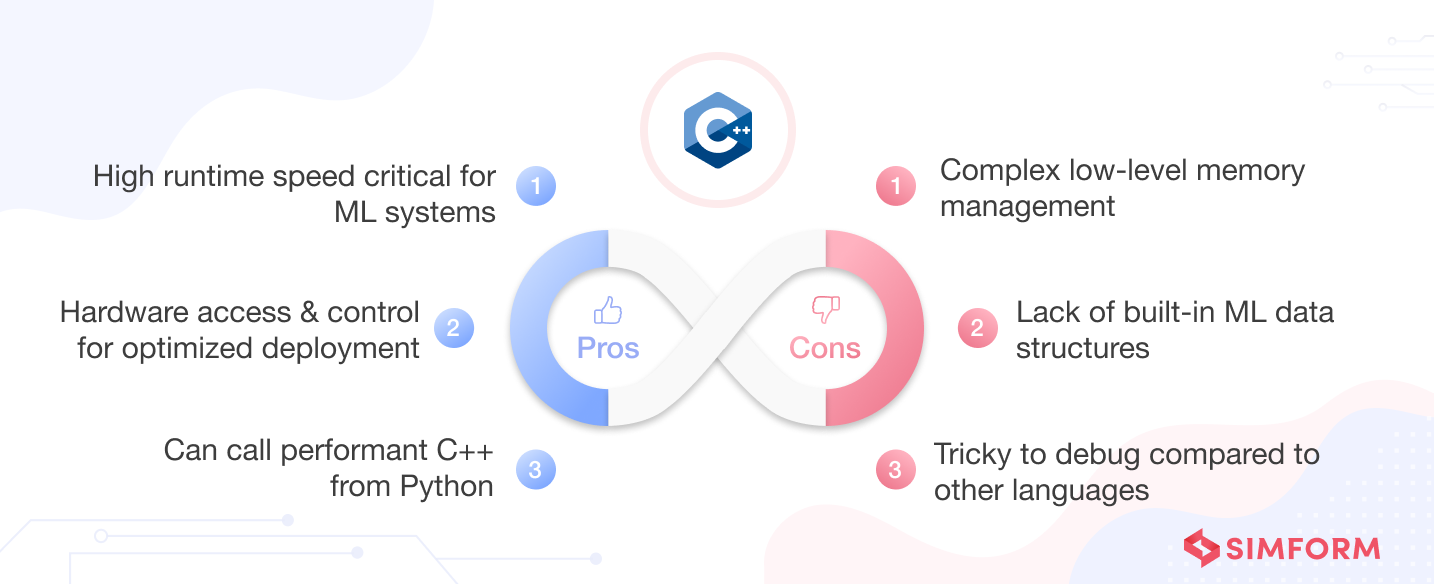
7. Lisp
Lisp is a powerful functional programming language notable for rule-based AI applications and logical reasoning. It represents knowledge as code and data in the same symbolic tree structures and can even modify its own code on the fly through metaprogramming.
Also, Lisp’s code syntax of nested lists makes it easy to analyze and process, which modern machine learning relies heavily on. Modern versions keep Lisp’s foundations but add helpful automation like memory management.
When it comes to key dialects and ecosystems, Clojure allows the use of Lisp capabilities on Java virtual machines. CLIPS facilitates building expert systems. By interfacing with TensorFlow, Lisp expands to modern statistical techniques like neural networks while retaining its symbolic strengths.
What is Lisp used for in AI?
Lisp stands out for AI systems built around complex symbolic knowledge or logic, like automated reasoning, natural language processing, game-playing algorithms, and logic programming. It represents information naturally as code and data symbols, intuitively encoding concepts and rules that drive AI applications.
While pioneering in AI historically, Lisp has lost ground to statistical machine learning and neural networks that have become more popular recently. But it remains uniquely suited to expert systems and decision-making logic dependent on symbolic reasoning rather than data models.
Its ability to rewrite its own code also makes Lisp adaptable for automated programming applications.
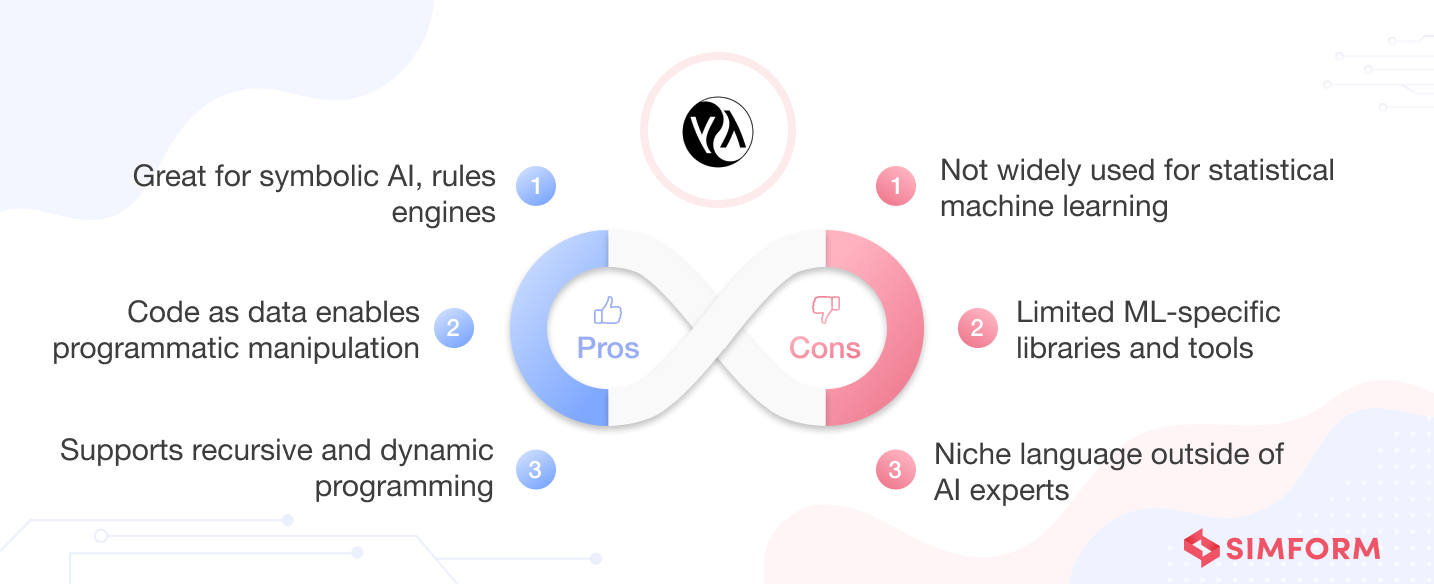
8. Haskell
Haskell is a purely functional programming language that uses pure math functions for AI algorithms. By avoiding side effects within functions, it reduces bugs and aids verification – useful in safety-critical systems.
The best part is that it evaluates code lazily, which means it only runs calculations when mandatory, boosting efficiency. It also makes it simple to abstract and declare reusable AI components.
Its libraries, like HLearn and LambdaNet, directly tackle machine learning and neural networks. At the same time, Haxcel and BayesHaskell provide support for the necessary linear algebra and probability math.
What is Haskell used for in AI?
Haskell is a natural fit for AI systems built on logic and symbolism, such as proving theorems, constraint programming, probabilistic modeling, and combinatorial search. It bridges mathematical specifications elegantly into running code. The language meshes well with the ways data scientists technically define AI algorithms.
Thanks to principled foundations and robust data types, Haskell provides correctness and flexibility for math-heavy AI.
Tip: Use Haskel for quality-critical AI applications in need of verifiable logical representation.
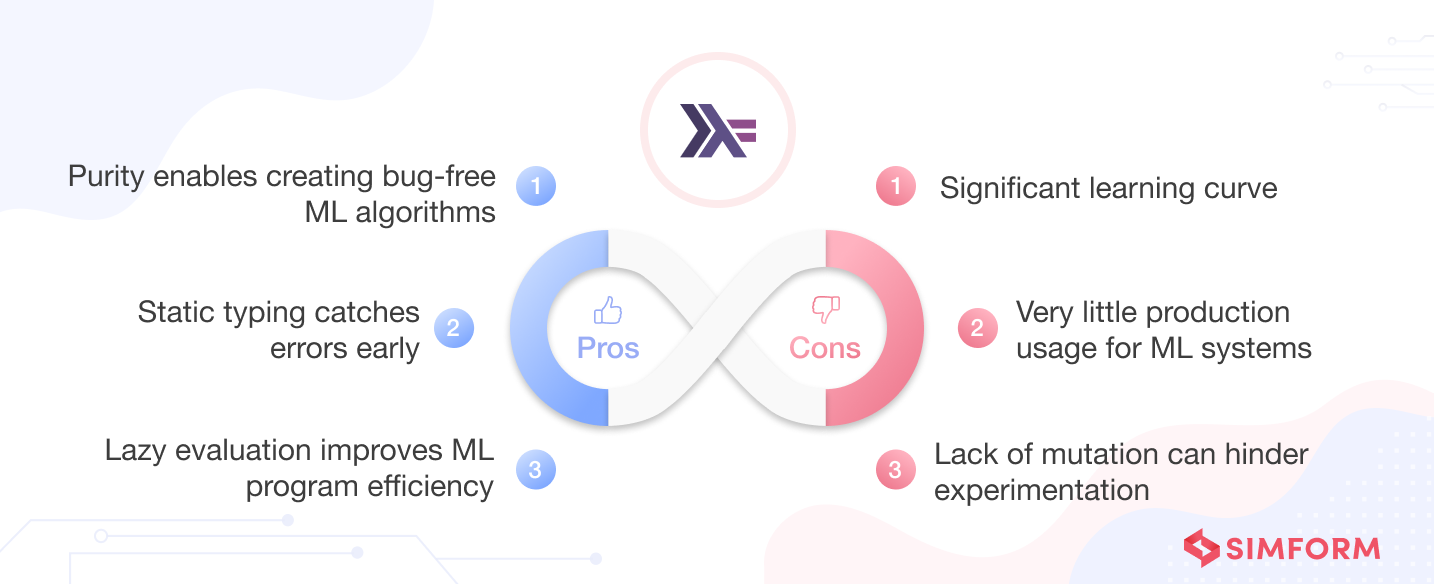
9. Prolog
Prolog is a declarative logic programming language that encodes knowledge directly into facts and rules, mirroring how humans structure information. It automatically deduces additional conclusions by connecting logic declarations.
Its declarative, query-based approach simplifies focusing on high-level AI goals rather than stepwise procedures.
Regarding libraries and frameworks, SWI-Prolog is an optimized open-source implementation preferred by the community. For more advanced probabilistic reasoning, ProbLog allows encoding logic with uncertainty measures. You can use libraries like DeepLogic that blend classic Prolog with differentiable components to integrate deep neural networks with symbolic strengths.
What is Prolog used for in AI?
Prolog performs well in AI systems focused on knowledge representation and reasoning, like expert systems, intelligent agents, formal verification, and structured databases. Its declarative approach helps intuitively model rich logical constraints while supporting automation through logic programming.
Tip: Use Prolog for explainable, rule-based deduction to verify and validate models or capture intricate relational knowledge.
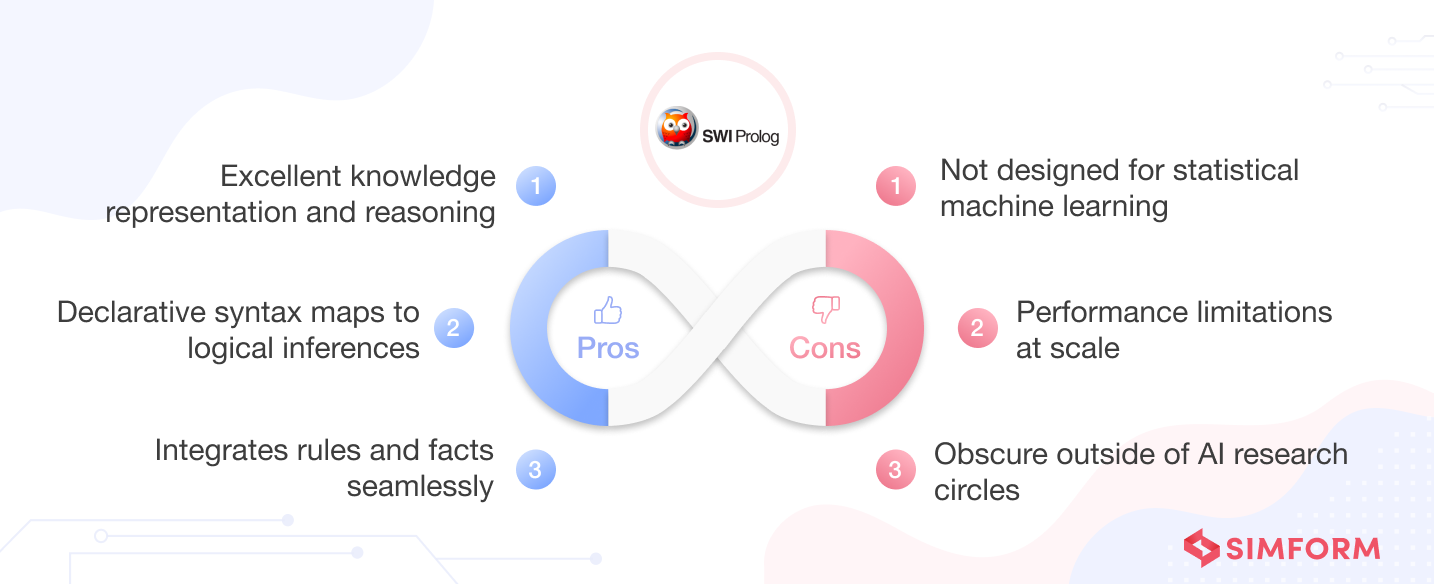
10. Scala
Scala fuses object-oriented and functional programming styles. This allows both modular data abstraction through classes and methods and mathematical clarity via pattern matching and immutability.
Moreover, Scala’s advanced type system uses inference for flexibility while ensuring robustness for scale through static checking. Asynchronous processes also enable the distribution of AI workloads across parallel infrastructure.
Specialty libraries extend Scala’s core advantages for AI, providing neural networks (ScalNet), numerics (Breeze), distributed machine learning on Spark, and interoperation with Java ecosystems like DeepLearning4J. Scala thus combines advanced language capabilities for productivity with access to an extensive technology stack.
What is Scala used for in AI?
Scala enables deploying machine learning into production at high performance. Its capabilities include real-time model serving and building streaming analytics pipelines. Plus, it has distributed data processing and robust feature engineering.
Scala also integrates tightly with big data ecosystems such as Spark. This helps accelerate math transformations underlying many machine learning techniques. It also unifies scalable, DevOps-ready AI applications within a single safe language.
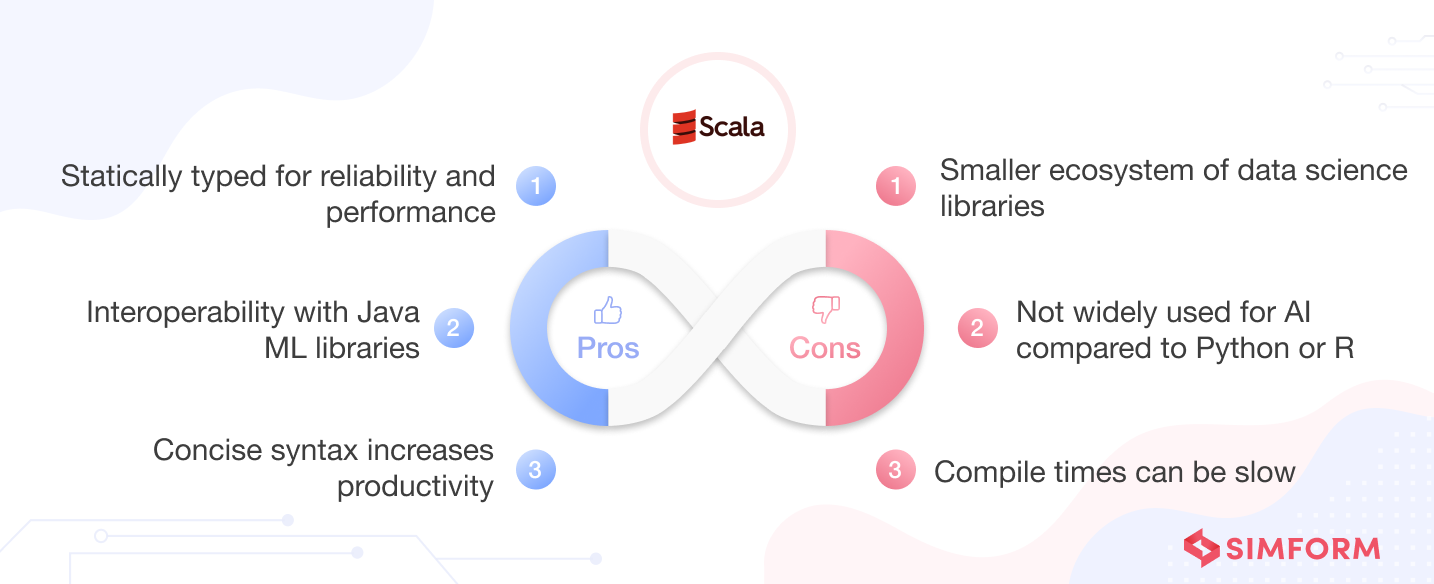
Comparative analysis of best AI programming languages
| Language | Strengths | Weakness | Usability | Common AI apps | Examples of AI apps |
| Python | Simple syntax, vast libraries, productive | Performance issues, GIL for threading | High, great for beginners & experts | Machine learning, computer vision, NLP | Siri, Alexa, Tesla Autopilot |
| R | Statistical modeling and analysis built-in | Not general purpose, steep learning curve | Moderate, for data scientists | Statistical analysis, data mining | IBM Watson Analytics, Google BigQuery ML |
| Java | Cross-platform, enterprise-ready, static typing | Verbose, not AI specialized | Moderate, good for production | Search algorithms, NLP, enterprise AI | Google Search, Cortana, Banking APIs |
| Julia | High performance, math capabilities | Newer language, smaller ecosystem | Moderate, similar to Python | Data science, numerical analysis | A central bank in the US, the NY Fed, uses Julia to do ML modeling to understand the US economy. |
| JavaScript | Ubiquitous, full stack web dev | Not optimized for math/ML | Moderate, front-end focused | Browser-based ML, Node.js backends | Chrome ML image search, Angular recommendation engine |
| C++ | Speed and efficiency, hardware control | Complex, systems programming | Hard, for advanced developers | Optimized ML apps, robotics | Stock trading systems, self-driving cars |
| Lisp | Symbolic AI, code as data constructs | Not widely used today, limited libraries | Moderate, niche usage | Early AI research, pattern recognition | SPIKE, the planning and scheduling application for the Hubble Space Telescope. |
| Haskell | Functional purity, type safety | Abstract, not widely used for AI | Hard, niche research usage | Theoretical ML research | Meta has worked on several Haskell projects including Sigma, an anti-abuse platform that processes more than a million requests per second. |
| Prolog | Logic programming, pattern matching | Limited adoption and libraries | Moderate, declarative style | Expert systems, natural language | The network interface configuration code of Microsoft Windows NT involved a Small Prolog interpreter. |
| Scala | Leverages Java, functional capabilities | Steep learning curve | Moderate, big data focused | ML on Spark, distributed systems | eSentire uses Scala for real-time cybersecurity solutions. |
Which is the right language for your AI needs
Choosing the best AI programming language comes down to understanding your specific goals and use case, as different languages serve different purposes.
For instance, Python is a safe bet for intelligent AI applications with frameworks like TensorFlow and PyTorch. However, for specialized systems with intense computational demands, consider alternatives like C++, Java, or Julia.
So, analyze your needs, use multiple other languages for artificial intelligence if necessary, and prioritize interoperability. Make informed decisions aligned with your strategic roadmap and focus on sound architectural principles and prototyping for future-ready AI development.